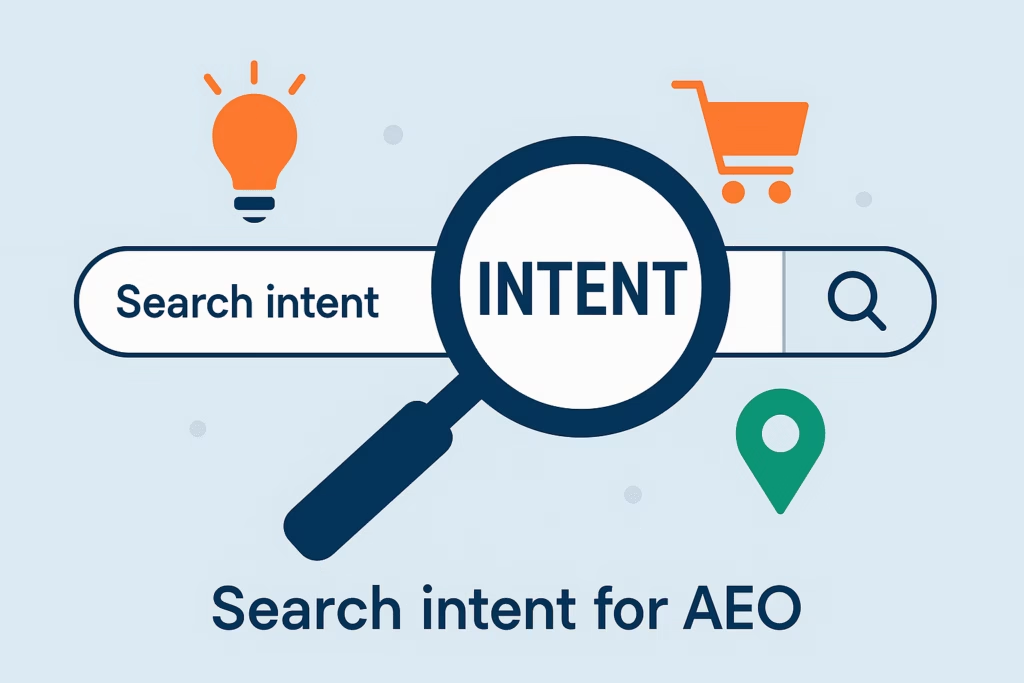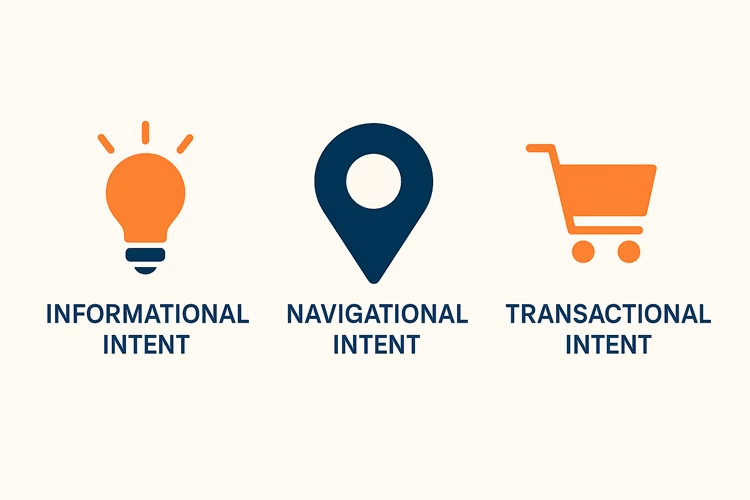
Let’s be real for a second. We’ve heard the same old SEO advice a hundred times, right? “Find the right keywords, optimize your page, sprinkle them here and there, and boom—you’re set.”
But if you’ve been paying attention to how search is evolving, you already know that this cookie-cutter formula doesn’t really cut it anymore. Today, search isn’t just about keywords—it’s about intent. And if you’re serious about Answer Engine Optimization (AEO), understanding search intent is pretty much the golden ticket for boosting your online presence.
So, let’s break it down together.
Why Search Intent Matters in AEO
Here’s the thing: Answer engines like Google’s featured snippets, Bing’s AI answers, and even ChatGPT-style search tools don’t just care about keywords. They care about the why behind the search.
- Why did the user type that query?
- What problem are they trying to solve?
- What format of answer would best satisfy them?
This is what we mean by understanding user intent. Once you get that part right, your content is more likely to be picked up as a quick, direct answer—and that’s exactly what AEO is all about.
Think of it like this: keywords are the “what.” Intent is the “why.” And AEO succeeds when you nail the answer for the “why”.

Types of Search Intent (and Why They’re Crucial for AEO)
When discussing search intent, most people immediately think of the three classic categories as they learned in traditional SEO: informational, navigational, and transactional. We also add commercial intent. But since we’re focused on AEO, let’s keep our eyes on the big one: informational intent.
1. Informational Intent
This is when someone just wants to know something. They’re not trying to buy yet, not looking for a brand. They’re simply looking for an answer.
Example: “What is informational intent in SEO?”
In AEO, this is gold. Why? Because answer engines love delivering quick, fact-based, trustworthy answers. If your content clearly explains concepts in plain language, you stand a strong chance of showing up.
2. Navigational Intent
This is when users are looking for a specific website, product, or brand.
Example: “Ahrefs blog” or “Amazon login.”
For AEO, this isn’t usually the main play. It means that you can’t outrank a brand for its own name. But it’s still worth knowing because sometimes users phrase navigational queries like questions. Look for those questions.
3. Transactional Intent
Now we’re talking business—literally. These users using this keyword intent are ready to buy.
Example: “Buy Apple Watch Series 9 online.”
For AEO, transactional intent is less about direct answers and more about helping guide decisions. (Though, let’s be honest—Google Shopping and ads usually dominate for these keywords.)
4. Commercial Intent
This one’s in between: the user wants to compare options before buying.
Example: “Best smartwatch under $50 USA.”
Here, AEO can shine if you provide structured comparisons, bullet points, or pros and cons.
If you want to explore various types of keywords, read this article.
Why Just Keywords Aren’t Enough Anymore
Imagine someone searches “best time to post on Instagram.”
If you just target the keyword and throw in a few paragraphs of low-quality content, you’ll lose. The user wants an answer—clear, quick, maybe even with a chart or bullet points.
That’s why search intent for AEO is about shaping your content around how users want the answer delivered, not just the words they typed.
Search engines are smarter than ever. They know if a person wants a list, a definition, a tutorial, or even a video. If your content doesn’t match that expectation, you’re invisible.
How to Understand User Intent (Without Overthinking It)
Okay, it’s like getting inside the head of your audience. Don’t worry—you don’t need a psychology degree. Here’s a simple process I use:
1. Look at the SERPs
Google has already done the homework for you. Type in your target query and see what shows up.
- Are the top results blog posts, tutorials, or quick answers?
- Do you see a featured snippet?
- Is there a “People Also Ask” box?
This tells you what Google believes matches intent. So, your content should be like that.
2. Study “People Also Ask” Questions
Seriously, this section is where you should focus on in search results. It shows you related questions users care about. They are perfect for building out AEO-friendly content.
3. Think Like a Beginner
Pretend you’re someone completely new to the topic. What would you actually want to know? What would confuse you?
This helps you avoid jargon and create more approachable answers.
4. Map Keywords to Intent
Instead of just listing keywords, group them by intent. For example:
- Informational: what is search intent, types of search intent
- Commercial: best keyword tools for intent analysis
- Transactional: buy keyword research tool online
This way, your content isn’t just keyword-rich—it’s intent-driven.
Optimizing Content for Informational Intent (AEO’s Sweet Spot)
Now comes the fun part: actually creating content that answers instead of just mentioning.
Here are a few tips I’d share if we were working on your site together:
- Start with the answer. Don’t bury the answer under fluff. If the question is “What is search intent?”—answer that in the first line. Then explain in detail.
- Use structured formats. Bullets, numbered lists, and comparison tables—all of these make it easy for engines to pull your content into snippets.
- Add depth for humans. AEO is about quick answers, yes, but don’t stop there. Once you give the short answer, expand for readers who want the full story.
- Cover related questions. If you’re writing about “informational intent,” also cover “transactional intent” and “navigational intent” on the same page. This creates topical authority.
- Think multi-format. Sometimes, the best answer isn’t text. It can be an infographic, short video, or step-by-step diagram. Create it.
Real Talk: What Happens If You Ignore Intent?
If you are overusing keywords without caring about intent, here’s what happens:
- You rank for the terms that don’t drive the right audience.
- People bounce off your page because it didn’t answer their question.
- Search engines stop trusting your content as an authority.
On the flip side, when you align your content with intent, magic happens:
- Your answers get pulled into snippets.
- Your site builds credibility with both users and engines.
- You attract the right visitors, not just traffic for the sake of traffic.
Wrapping It Up
So, here’s the big takeaway: search intent for AEO isn’t about stuffing the right words—it’s about understanding the human behind the query.
When you start creating content that answers questions in the way people actually want them answered, you go from chasing rankings to earning them naturally.
Think about it: answer engines are trying to mimic a helpful friend. If your content already feels like that—clear, friendly, trustworthy, you’re giving them exactly what they want to showcase.
So next time you’re planning content, don’t just ask, “What’s the keyword?” Ask, “What’s the intent?” and write based on that intent. Trust me, that’s where the real SEO (and AEO) magic happens.
Your turn: Have you ever created a piece of content that nailed user intent and suddenly ranked way better than expected? I’d love to hear about it in the comment section.
How does search intent fit into AEO?
Understanding search intent is about uncovering *why* someone is searching—not just the words they’re typing. So your content can *answer* questions directly. In AEO, nailing intent means your content becomes the go-to, AI-ready answer.
Why is informational intent a key driver for AEO success?
Informational intent is gold for AEO. People are asking “what,” “how,” or “why” questions. If your content gives clear, concise answers, AI-powered tools are much more likely to pull it into featured snippets or chatbot responses.
How can I figure out what users really intend when they search?
Start by checking out the SERP: are there featured snippets, Google’s People Also Ask (PAA), or Knowledge Panels? These clues show you what format and depth users expect. PAA, especially, reveals real follow-up questions people are asking.
Is it possible to win AEO for transactional searches?
You can—but it’s a tougher path. For transactional queries (like “buy X online”), top placements often go to ads or product listings. Instead, focus on helpful buying guides, comparisons, or quick recommendation-style answers that still appeal to answer engines.
What happens if my content misses the user’s intent?
If your content doesn’t align with what users expect, they leave fast—and search engines notice. That hurts rankings and your credibility over time. Matching intent means better engagement, stronger trust, and more visibility.
Learning more helps to achieve bright success. Check out these books and courses:
Also, read this article – How to Optimize for Featured Snippets
Disclosure: We are partners or associates of Amazon and other top brands. We may earn a small amount from qualifying purchases without increasing the price. Please read our full affiliate disclosure here.
Ibochouba Singh is a content writer and reviewer with a passion for writing about digital marketing and tech gadgets, including software tools and new tech gadgets. He has over 15 years of experience writing for several consumers and clients, including tech startups, marketing agencies, and software companies. He has written many articles and product reviews for many websites, including nigcworld.com and 99learners.in.
